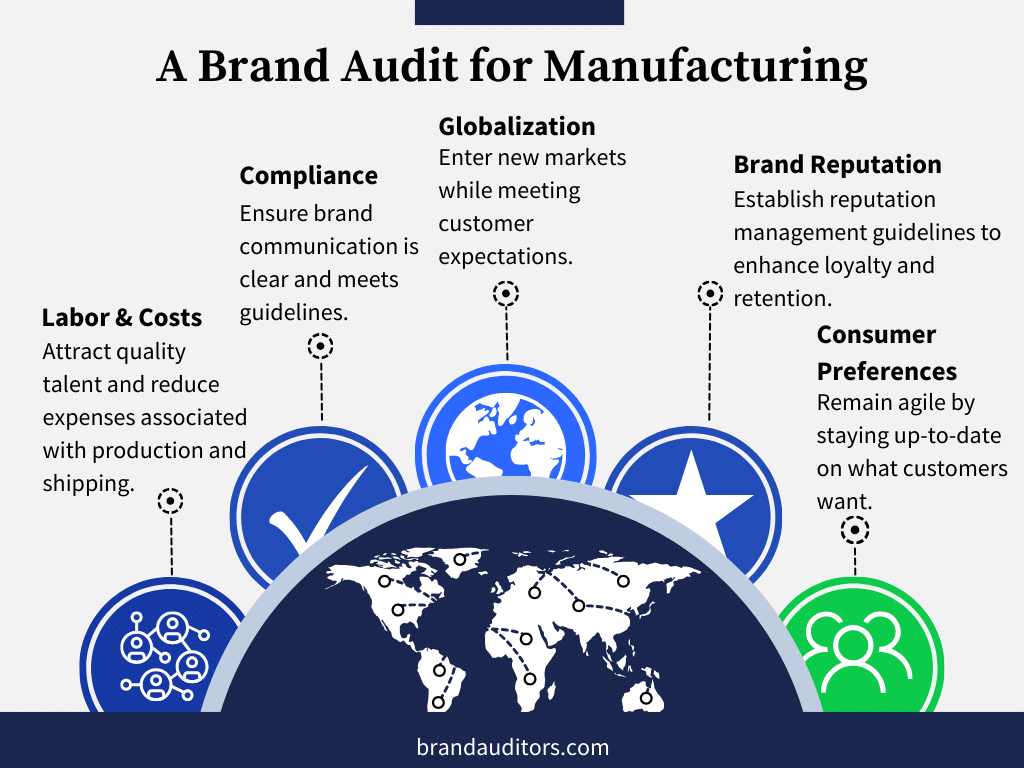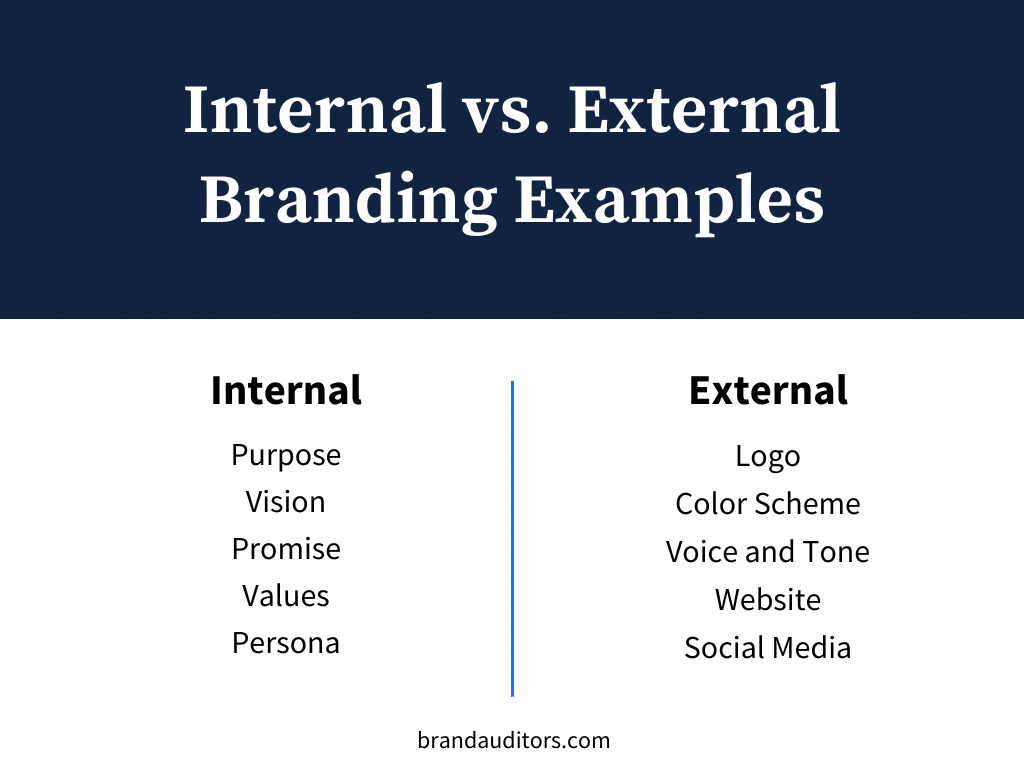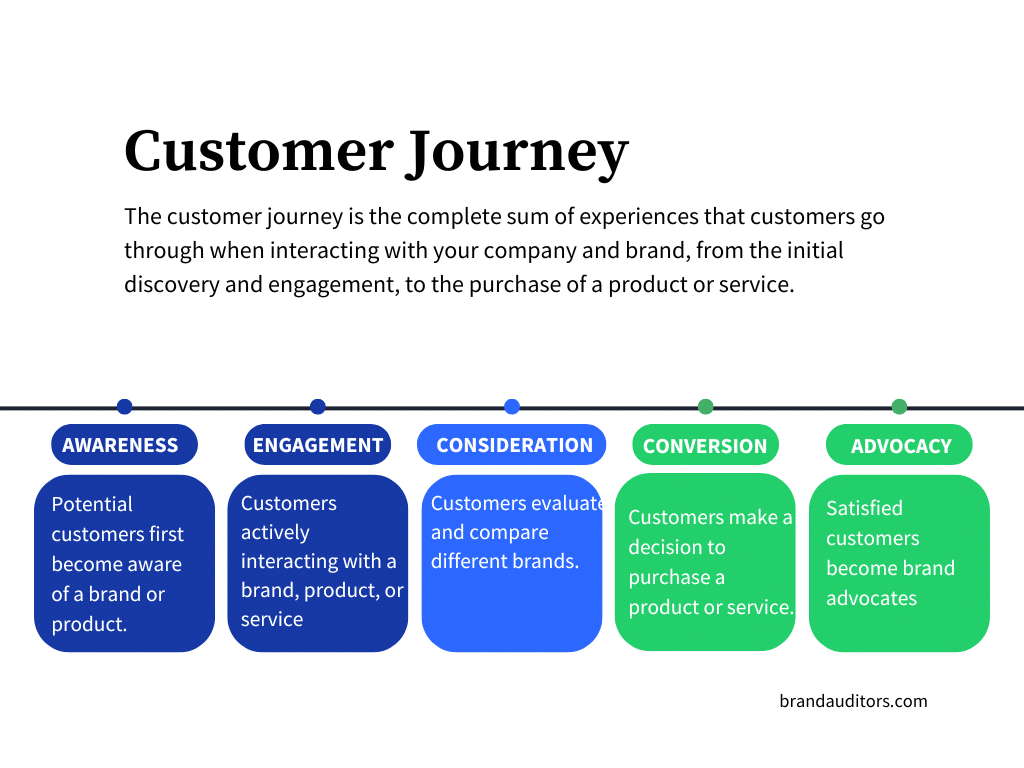A Brand Audit for Manufacturing Companies
Optimize your manufacturing brand's potential with a detailed brand audit for manufacturing companies. Explore more on our blog.
April 24, 2025

Your brand is a valuable asset. It represents your company and should reflect its identity, unique value, and reputation. Most of all, the brand is the bridge between your organization and its most profitable customers.
However, as time passes, a brand may stagnate. Other times, companies outgrow their identities or lose them in a merger. These are common in the manufacturing industry.
A brand audit for manufacturing companies can help them revitalize their image, inside and out.
An audit is an in-depth assessment of a business’s performance, market position, and customer perception. For manufacturing companies, an audit can help them navigate the complexities of a competitive marketplace.
In this blog, you will learn more about the process of conducting a brand audit for manufacturing companies. We will explore the key components of an audit, steps involved, and how to put an action plan in place.
How often should manufacturing companies conduct a brand audit?
Manufacturing companies should conduct a brand audit at least once a year to stay competitive. An annual audit allows manufacturers to evaluate market perception, strengths and weaknesses, and align strategies with business goals for sustained growth.
The benefits of a brand audit for manufacturing companies
A brand audit for manufacturing companies will provide a snapshot of their company’s current situation. But they will also discover the steps they need to take to manage the unique challenges they face. Let’s look at some examples.
Supply chain disruptions
During the audit, you will compare what your company delivers with what your supply chain can actually help you deliver. This process enables companies avoid making promises they can’t keep when disruptions occur. The added transparency builds trust with customers.
The audit may also highlight weaknesses in the supply chain so you can find backup suppliers to avoid future problems. This may prompt you to check in with your current suppliers to discuss potential problems that may arise and solutions.
Labor shortages and skills gap
An audit includes a review of your internal brand (see below). In this step, you’ll find out if your company’s culture and values are capable of attracting top talent. You may find that there is an opportunity to create a more appealing workplace as well as developing processes for training and upskilling programs.
Cost pressures
A brand audit for manufacturing companies addresses how to manage competitive cost pressures. The auditor will evaluate the perceived value of your company’s offers in the market and compare them to direct (and a few indirect) competitors. This is the best way to determine if you are using the optimal price strategy. You’ll also discover whether your company can demand a premium price based on quality and brand value, or if another pricing strategy is preferable.
The audit can may uncover opportunities to streamline operations and reduce costs in areas that don’t directly affect the company’s core value proposition. For instance, you may uncover inefficiencies in marketing spending or packaging that can be optimized without compromising quality.

Adapting to technological advancements
During an audit, you will analyze industry best practices and processes used by competitors. The findings can shed light on emerging technologies that are reshaping the manufacturing sector. This aids companies in making better decisions about where and how to invest resources for technological improvements. These investments might include innovative automation, robotics, or artificial intelligence.
Another important finding in an audit is the company’s current perception in relation to technological innovation. If the company lags behind competitors, customers may feel the business is falling behind and unable to deliver quality. Leadership can make adjustments to ensure the brand remains relevant and attractive to tech-savvy consumers and partners.
Regulatory compliance
A brand audit for manufacturing companies won’t always cover the technical aspects of regulatory compliance, but they do contribute to a manufacturing company’s overall compliance efforts. The auditor will evaluate the company’s messaging and communication strategies to gauge its commitment to compliance and ethics. Companies must make it clear that they are following the rules if they want to build trust with consumers.
You may also uncover discrepancies or inconsistencies between the company’s stated values and its actual practices. For example, if a manufacturer claims to prioritize safety and environmental responsibility but isn’t following through, an audit will bring these issues to the surface. Addressing these inconsistencies is essential for compliance and for maintaining a strong and credible reputation.
Shifting consumer preferences
Consumers’ preferences change quickly. Many manufacturers find themselves chasing shifts in customer preferences, which could put them at risk of losing touch with them.
During a brand audit for manufacturing companies, you will gather customer feedback and study market trends. This process gives companies insights into evolving consumer desires and preferences as well as how to adapt. As a result, businesses can improve product development, marketing strategies, and competitive positioning to remain relevant.
Globalization
Many manufacturing companies want to enter new markets. A brand audit is one of the best ways to prepare for this move. Before taking the plunge, companies must determine who they will target and how. Budgeting is also a concern. An audit will show companies how different regions or cultures perceive their brand and similar offerings. This enables them to develop targeted marketing efforts and adaptation strategies.
Maintaining a positive brand reputation
A brand audit for manufacturing companies can be a valuable tool for evaluating a company’s reputation management practices. Businesses will discover what customers really think about them. The auditor will collect online reviews, social media mentions, and any other feedback they can find to understand consumer sentiment.
Along the way, you may find out how to improve communication strategies, customer service protocols, or crisis management plans. This enables companies can proactively address any issues that may arise that could impact their reputation.
Data security and cybersecurity
When conducting a brand audit for manufacturing companies, it is important to explore data security and cybersecurity considerations. While traditional audits may not directly cover this aspect, organizations must understand the impact data protection protocols have on maintaining integrity and a good reputation.
An audit that includes cybersecurity measures demonstrates a commitment to ethical business practices and regulatory compliance. This showcases the company’s dedication to safeguarding customer information and maintaining privacy standards, which helps build a trustworthy image.

Step-by-step guide to conducting a brand audit for manufacturing companies
In this section, we will go over a step-by-step process for conducting an audit.
Step 1: Develop brand audit objectives
Defining clear objectives is the first step in any brand audit. Objectives might include assessing brand perception, evaluating the consistency of brand messaging, or exploring opportunities for brand revitalization.
The objectives set the scope and direction of the audit and align it with the company’s broader business goals and marketing strategies. By setting these goals upfront, you can ensure that you will get the insights you need to improve performance and drive growth.
Step 2: Gathering data
A brand audit for manufacturing companies requires a diverse range of data to paint an accurate picture of the company’s health and performance.
Examples of internal data are company documents outlining brand values and positioning, employee surveys for their perspectives, sales figures for performance analysis, financial data for ROI assessment, and internal communications for message consistency checks.
You will also need external data, such as customer feedback, surveys, focus groups, insights from social media platforms, online reviews, and web analytics. All of these contribute to understanding customer perceptions and brand reputation.
Competitive analysis and market research data provide valuable context about the brand’s position in the market and potential growth opportunities.
Step 3: The brand audit team
A successful brand audit for manufacturing companies relies on a diverse team of experts, each playing a key role in the process. This team typically includes:
- Project manager: This person oversees the entire audit, sets deadlines, and makes sure everyone is working together smoothly.
- Brand strategist: The architect who develops the audit plan, pinpoints key areas to assess, and provides expert advice throughout.
- Marketing analyst: This person digs into numbers and information about how the brand is performing, where it stands in the market, and what customers think. They then use this data to offer valuable insights and suggestions.
- Creative designer: The visual expert who focuses on the look and feel of the brand, evaluating everything from the logo to the overall style to make sure it’s consistent and effective.
- Sales representative: The voice of the customer, this individual shares firsthand knowledge about what customers are saying, how sales are going, and what’s happening in the market.
Step 4: Internal branding
Understanding your internal brand health is a foundational step in any audit. If your employees don’t believe in or understand your brand, it’s unlikely your customers will either.
A comprehensive internal audit dives into several key areas:
- Employee alignment: This explores how well your team understands and connects with the company’s core values, mission, and brand identity. Do they feel proud to work for your company? Do they know what makes your company unique? Are they actively promoting the brand’s values in their work?
- Training: This assesses how well-equipped employees are to communicate the story, products, and services. Are they knowledgeable about what the company offers? Do they understand key messages and how to convey them to customers?
- Internal communication: This examines how the brand is communicated within the company itself. Are internal messages consistent with the external image? Do employees receive regular updates and information about the brand’s evolution? Is there a sense of transparency and open communication?

Step 5: External branding
The external brand review zooms in on how it is perceived by the outside world-customers, potential clients, and the general public. It scrutinizes every touchpoint where your brand interacts with audiences to ensure your message is consistent, impactful, and resonates with your target market.
Key external areas of focus include:
- Visual identity: This encompasses the visual elements, such as your logo and color palette to the typography and overall design aesthetic used in your marketing materials. A consistent and visually appealing identity reinforces recognition and leaves a lasting impression.
- Messaging and communication: This involves evaluating the clarity, consistency, and effectiveness of your messaging across all channels – website, advertising, social media, press releases, etc. Does your messaging accurately reflect your brand promise? Is it compelling and engaging for your target audience?
- Social media presence: This examines how active and effective you are on social platforms. It involves analyzing metrics like engagement rates, follower growth, and sentiment analysis to gauge how well you connect with the online audience.
- Customer feedback: This includes gathering and analyzing customer reviews, surveys, and feedback across various channels. It provides valuable insights into customer perception, their satisfaction levels, and areas for improvement.
- Market perception: This involves assessing your reputation and visibility in the marketplace. It considers factors like brand awareness, market share, and overall perception compared to competitors.
Step 6: Evaluate product branding
Evaluating product involves a review of the brand’s products and services. This assessment focuses on several key aspects, including how well each product embodies and communicates the company’s core values, how effectively it aligns with the overall brand positioning and messaging, and whether it successfully delivers on the brand promise made to customers.
The audit identifies how to improve products. This could involve enhancing product features, refining marketing messages, or adjusting pricing strategies. Consistency is also a key focus, ensuring that each product complements the overall brand identity and contributes to a cohesive experience for the customer.
Step 7: Target audience analysis
This step goes beyond simply identifying potential customers. It explores their motivations, preferences, and behaviors.
Market research is a key component of this step, providing insights into what your customers truly need and value. By understanding their pain points, desires, and purchasing habits, you can tailor your branding and marketing messages to resonate with them on a deeper level.
Examining customer demographics-factors like age, gender, location, income, and interests-helps create a detailed profile of your ideal customer. This granular understanding allows you to craft targeted campaigns that speak directly to specific segments of your audience, increasing the effectiveness of your marketing efforts.
Equally important is gathering customer feedback through surveys, focus groups, or social media listening. This feedback loop provides a direct line of communication with your audience, revealing their perceptions and experiences with your brand. Both positive and negative feedback are valuable, as they highlight areas where your business excels and areas where there’s room for improvement.

Step 8: Competitor analysis
A competitor analysis looks at the strategies, current position, and performance metrics of your direct competitors.
Competitor analysis includes examining their visual identity, messaging, and overall positioning in the market. By dissecting how they communicate their unique value propositions and what sets them apart, you can gain valuable insights into what resonates with customers in your industry.
Competitor analysis evaluates their market position and key performance indicators. This encompasses factors such as customer perception, unique selling proposition, market share, and customer loyalty. By understanding their strengths and weaknesses, you can benchmark your own brand’s performance and identify areas where you can outshine the competition.
The ultimate goal of this step is to help you differentiate your business from the competition, capitalize on their weaknesses, and ultimately carve out a stronger position in the market.
Step 9: Assess your marketing strategy
A brand audit for manufacturing companies includes an evaluation of your overall marketing strategy. To optimize results, you must assess the effectiveness of your marketing efforts across various channels of the customer experience.
The audit covers everything you use to reach customers, such as the content marketing strategy, including the quality, relevance, and consistency of your website content, blog posts, and social media content. It evaluates how well your content communicates your brand values and resonates with your target audience.
Another crucial aspect is the analysis of your conversion rate and customer acquisition strategies. This involves evaluating the effectiveness of your lead generation tactics, conversion funnels, and overall customer acquisition process. The audit seeks to pinpoint any bottlenecks or areas of friction that hinder customer engagement and conversions.
By examining these various elements of your marketing strategy, you can decide how to refine your marketing efforts, allocate resources effectively, and drive greater ROI for your manufacturing company.

The value of working with a brand auditor
A brand auditor acts as a navigator, guiding manufacturing companies through the findings and transforming insights into actionable strategies. They bring an unbiased perspective, specialized expertise, and a data-driven approach to help companies make sense of the audit results and create a roadmap for implementation.
Brand auditors sift through the vast amount of collected data, pinpointing recurring themes and patterns that reveal the brand’s strengths, weaknesses, opportunities, and threats. They connect the dots between different data points, such as customer feedback, market research, and internal surveys, to uncover deeper insights.
- Example: If customer reviews consistently praise product quality but criticize slow delivery times, the auditor can identify this and potential resolutions.
Not all findings are created equal. An auditor helps prioritize the most critical issues that require immediate attention. They consider the potential impact of each finding on the company’s reputation, market position, and business goals.
- Example: If the audit reveals a disconnect between the company’s internal culture and its messaging, this might take priority over minor inconsistencies in the visual identity.
Auditors don’t just present raw data, they also interpret it within the broader context of the industry, market trends, and the company’s specific goals. They offer insights into what the findings mean for the brand’s future and how they can be leveraged for growth.
- Example: If an audit reveals that a competitor is gaining market share with a particular product feature, the auditor can help the company understand why this is happening and recommend strategies to respond.
Brand auditors diagnose problems and prescribe solutions. They translate the audit findings into actionable strategies that align with the company’s goals and resources.
- Example: If the audit reveals a lack of brand awareness among a key target audience, the auditor might recommend a targeted advertising campaign or a social media influencer partnership.
A brand auditor helps establish clear, measurable goals for the action plan. This ensures that progress can be tracked and evaluated over time.
- Example: A goal might be to increase brand awareness by 15 percent within six months of implementing the action plan.
Brand auditors help companies allocate their resources (i.e., time, budget, and personnel) in the most efficient way to achieve their objectives.
- Example: The auditor might recommend investing in employee training programs to improve customer service or reallocating marketing funds to channels that are more effective in reaching the target audience.
Auditors often provide ongoing support to track the progress of the action plan and make adjustments as needed. This ensures that the company stays on track and achieves the desired outcomes.
- Example: The auditor might conduct regular check-ins with the company to review progress, analyze data, and make recommendations for optimizing the strategy.
By partnering with a brand audit firm, manufacturing companies can gain valuable expertise and guidance throughout the process. This partnership empowers companies to transform audit findings into actionable strategies, leading to a stronger identity, improved customer loyalty, and ultimately, increased business success.
The Brand Auditors: Our manufacturing audit process
A brand audit for manufacturing companies can help them revitalize their image and remain competitive. By understanding and addressing unique challenges and opportunities, you can develop actionable strategies to enhance your market positioning.
Are you ready to optimize your growth strategy? Get a free consultation with our experts today.
Ready to learn more?
Connect with a strategist for a no-obligation session designed to pinpoint your brand's biggest opportunities and get a clear path to successful outcomes.

POST AUTHOR
Core services
Digital marketing
audit services
Discover how to improve marketing campaigns, strengthen the impact of every customer touchpoint, and focus resources on the actions that generate more revenue.
Customer experience strategy consulting
Turn raw customer data into audience personas and laser-focused messaging.
